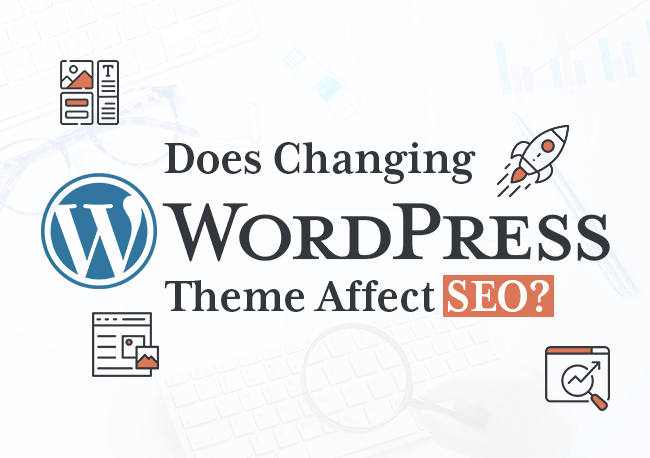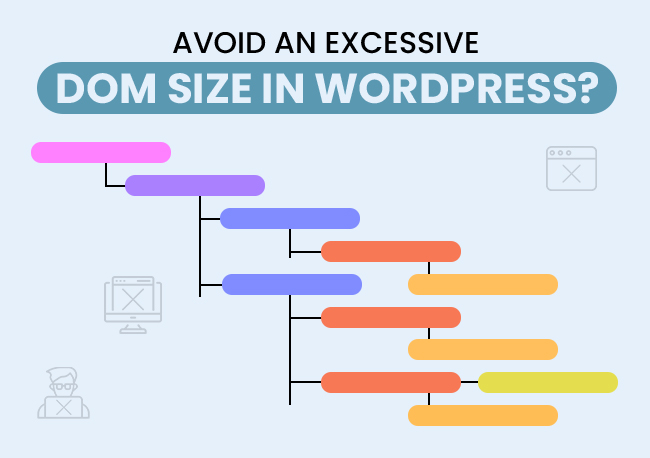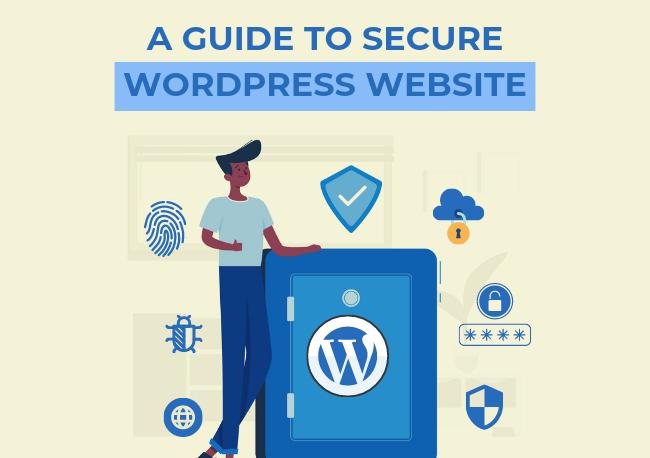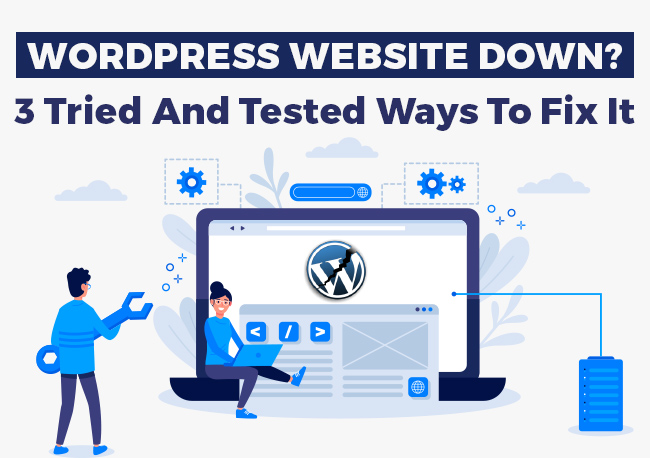| Getting your Trinity Audio player ready... |
We all have heard that “Change is constant.” Some changes allow you to learn and grow, and embracing those changes can boost innovation and progress. This concept holds true for technical considerations as well.
Picture this, You have put a lot of effort into designing your website, choosing the right colors, arranging everything perfectly, and making it look awesome. But then comes a time when you feel like it’s time for a change.
Maybe you want to try out a new style or need more features than your current theme offers. But here’s the kicker, you wonder if making this change will mess up all the work you have done to make your website show up on Google.
That’s where we come in. We are here to determine if changing your WordPress theme could mess with your website’s search engine rankings.
Let’s start by understanding what WordPress themes are all about and then dig into how changing them might affect your SEO game. So, get ready for a journey where we break down the relationship between your website’s look and its search engine rank.
Let’s dive into it!
Role of Themes on Website
To understand this in simple language, Imagine a website like a house. Now, imagine themes as the decoration style of that house. When you visit a friend’s house, you might notice they have a certain theme, like modern, vintage, or minimalist. In the same way, a website’s theme sets the overall look and feel.
It’s like deciding if your website will have bright colors and big pictures or maybe it will be more professional with clean lines and subdued colors.
Themes help visitors understand your website without having to read everything. For example, if you are running a blog about gardening, a nature-inspired theme with green colors, floral designs, and maybe even some leafy textures would instantly tell visitors that your website is related to plants and gardening.
So, the role of themes on a website is to make it visually appealing and to communicate its purpose or content quickly and clearly to visitors, just like how the decoration of a house reflects the personality and interests of its owner.
Also Read: What Makes A Good Website Checklist? A Complete Guide
Connection Between Website Design & SEO Performance
As we used the example of the house to explain the concept of the theme above, let’s continue that example.
As your website is a house, the design of the house, like its layout, colors, and decorations, is similar to the design of a website. Think of SEO as the roads and signs that lead people to your house.
Also Read: A Complete SEO Strategy Guide For New Websites
Here’s how it works:
➢ Layout and Structure: Just like a house needs to be well-organized and easy to navigate, your website should have a clear layout. This means having logical menus, easy-to-find information, and a structure that makes sense to visitors. These factors make your website professional in front of users.
Search engines like Google prefer websites that are well-structured because they can easily understand what your website is about.
Also Read: Difference Between Parent Theme & Child Theme In WordPress
➢ Speed and Performance: If your house is easy to access and has no roadblocks, more people will visit, right? In the same way, if your website loads quickly and performs well on different devices, search engines will rank it higher.
This means more people will find your website when they search for relevant topics.
Also Read: Why Does My Website Load Slowly?
➢ Mobile-Friendliness: Nowadays, as you all know, many people use their smartphones to browse the internet. So, if your website looks good and works well on mobile devices, more visitors will stay longer and explore.
Search engines value mobile-friendly websites and prioritize them in search results.
Importance of Selecting a Suitable Theme For Your Website
What makes a house appealing and welcoming?
It’s the design, right?
The paint colors, furniture arrangement, and decorations all contribute to its vibe!
Well, think of a website theme as the design for your online home.
Choosing the right theme is important because it sets the tone for your website. It’s like picking the style for your house – modern, classic, cozy, or funky. The theme determines how your website looks and feels to visitors.
Now, why does this matter? Imagine you are a fashion brand, but your website looks like it’s selling gardening tools.
Confusing, right?
As discussed above, your theme should match what you are all about. If you are a photographer, your website should showcase your photos beautifully. If you are a blogger, your theme should make your writing easy to read and engaging.
Plus, a good WordPress theme makes navigation easier. It’s like having clear signs in your house so guests can find their way around easily. A well-chosen theme organizes your content, making it simple for visitors to explore your website and find what they want.
So, when picking a theme for your WordPress website, think about what suits your style and purpose best. It’s like picking the perfect outfit for a special occasion. You want to look your best and make a great impression!
How Does Changing WordPress Themes Affect SEO?
➢ Potential Positive Impacts
1. Your User Experience May Improve
When we talk about the user experience (UX), we refer to how visitors feel when interacting with your website. It’s the same as the atmosphere of a store – if it’s welcoming and easy to navigate, customers are more likely to stay and explore.
Similarly, by investing in a new theme for your WordPress website, you can create a more inviting and user-friendly environment for your visitors. By this, you are optimizing your website for better performance.
This can lead to longer visit durations, lower bounce rates, and more engagement and conversions. So, improving your user experience through these changes is not just about aesthetics. This means visitors will enjoy being on your site more, which is good for SEO.
Also Read: How To Avoid An Excessive DOM Size In WordPress?
2. Enhancements in Mobile Responsiveness
Enhancements in mobile responsiveness mean ensuring your website looks and works well on mobile devices like smartphones and tablets. When you change themes on your website, you have the opportunity to improve how it appears and functions on mobile devices.
This could involve adjusting the layout to be more user-friendly on smaller screens, making buttons and links easier to tap with fingers, and ensuring that images and text resize properly to fit different screen sizes.
By enhancing mobile responsiveness, you are providing a better experience for your mobile visitors and signaling to search engines like Google that your website is mobile-friendly. So having a theme optimized for mobile devices can positively impact your SEO efforts.
3. You Can Get an Optimized Code Structure
Imagine your website is a big puzzle. When you change themes, you might get a new puzzle with pieces that fit together better. This makes your site load faster and easier for search engines to understand.
When you decide to change the theme of your website, you are essentially overhauling its appearance and functionality. However, it’s not just about the visual changes; it also involves what’s happening behind the scenes – THE CODE.
Think of the code structure of your website as its backbone. It’s what holds everything together and determines how your website functions. When you switch to a new theme, you have the opportunity to get a fresh set of code that is optimized for performance and efficiency.
An optimized code structure is important for faster loading times, improved accessibility, and better compatibility with your WordPress website. In short, getting an optimized code structure through a theme change can have significant benefits for your website’s performance, user experience, and SEO.
So, when considering a theme change, don’t overlook the importance of optimizing your website’s code.
4. Improvement in SEO-Friendly Features
Improvement in SEO-Friendly features means that when you change your website’s theme, you’re potentially upgrading elements that help search engines understand and rank your site better.
Here’s a detailed explanation:
➔ You are offering a cleaner & more organized structure optimized structure on your WordPress website with your new theme, which is beneficial for SEO.
➔ There are many WordPress themes that include built-in schema markup that offers search engines additional information about your content. This can enhance your site’s visibility in search results by enabling rich snippets
➔ With modern WordPress themes; you are offering a responsive design that ensures your website looks good and functions well across different devices and screen sizes. Search engines like Google give preference to mobile-friendly websites, so having a responsive theme can positively impact your SEO.
➔ There are many newer themes are optimized for speed, which is a crucial factor in SEO rankings. Faster-loading pages lead to better user experience and higher engagement, both of which are important for a website’s SEO.
Also Read: Difference Between On-Page And Off-Page SEO?
5. The Benefit of Getting Security Enhancements
Changing themes can be like getting a security upgrade for your website. This keeps hackers away and makes your website safer for visitors. Search engines like safe sites, which can also help your SEO.
When you decide to change your WordPress website’s theme, you’re not just giving it a fresh look; you’re also taking a step towards enhancing its security.
Also Read: A Guide To Secure WordPress Website – A Complete Checklist
Here’s why this is important:
➔ Security enhancements provided by newer themes often include advanced measures to safeguard your WordPress website against cyber threats such as hacking, malware, and other malicious activities.
➔ With security enhancements in place, the likelihood of experiencing a data breach is significantly reduced. Data breaches can have severe consequences, including financial losses, damage to your reputation, and legal liabilities.
By prioritizing security when changing themes, you’re actively mitigating the risks associated with unauthorized access to your website’s data.
➔ A secure website inspires trust and confidence among your visitors. When users see that your website is equipped with robust security features, they feel more comfortable engaging with your content, making purchases, or providing personal information.
This increased trust can lead to higher conversions, improved customer retention, and a positive reputation for your brand.
Also Read: Click-Through Rate (CTR) Vs Conversion Rate: All You Need To Know
In short, prioritizing security enhancements when changing website themes is crucial for safeguarding your online presence and protecting your business and users from potential harm. By investing in security, you are not only fortifying your website against cyber threats but also reinforcing trust, compliance, and resilience in an increasingly digital world.
Changing themes can be like getting a security upgrade for your website. This keeps hackers away and makes your site safer for visitors. Search engines like safe sites, so this can help your SEO too.
Also Read: Does SSL Help SEO? Discover Eye-Opening Insights
6. Improvement in Content Presentation
When you change themes, you might find better ways to showcase your content. This makes it easier for visitors to find what they’re looking for, which makes them stay longer on your website
Improvement in Content Presentation refers to the enhancement of how you organize the website’s content for your visitors. When you change themes, you have the opportunity to refine the layout, design, and overall presentation of your content in a way that makes it more appealing and easier to consume.
Here’s a more detailed look at how changing themes can improve content presentation:
➔ Different themes offer various layout options, such as grid layouts, magazine-style layouts, or single-column designs. By choosing a WordPress theme that complements your content type and structure, you can create a visually appealing layout that effectively showcases your content.
➔ Fonts, font sizes, and spacing are crucial in readability. A new theme may offer better typography options, allowing you to choose fonts that are easier to read and adjust font sizes for improved legibility across different devices.
➔ Themes often include features like image sliders, galleries, and featured content sections that can enhance the visual appeal of your website. These visual elements can help break up text-heavy pages, engage visitors, and highlight important content.
➔ The color scheme of your website can impact your content’s overall look and feel. Changing themes allows you to experiment with different color palettes to find one that complements your brand identity and creates a cohesive visual experience for your visitors.
Overall, by selecting a theme that prioritizes content presentation and customization options, you can create a website that looks great and effectively communicates your message to your audience.
A well-presented website is more likely to engage visitors, encourage them to explore further, and ultimately contribute to improved SEO performance.
Also Read: What Should You Consider When Developing Website Content?
➢ Potential Negative Impacts
1. Impact on Website Speed & Performance
Changing themes can affect website speed and performance if the new theme is poorly optimized or contains bulky code. Themes with excessive Javascript, CSS, or large image files can slow down page load times, which in turn can negatively impact SEO.
Search engines like Google consider page speed as a ranking factor so slower websites may experience a drop in search engine rankings.
Also Read: Ways To Optimize Your WordPress Website For Speed
2. Incompatibility With SEO Plugins
Some themes may not be fully compatible with SEO plugins or may conflict with the settings of existing plugins. This can lead to missing meta tags, broken schema markup, or incorrect canonical URLs.
These inconsistencies can confuse search engine crawlers and affect the website’s visibility in search results.
Also Read: 22 Best Plugins For WordPress
3. Mobile Responsiveness Issues
With the increasing use of mobile devices for internet browsing, mobile responsiveness has become a crucial factor in SEO. Changing to a theme that is not properly optimized for mobile devices can result in a poor user experience on smartphones and tablets.
Search engines prioritize mobile-friendly websites in their rankings, so a lack of mobile responsiveness can decrease search engine visibility.
4. Negative User Experience
If the new theme significantly changes the layout, navigation, or overall design of the website, it may result in a negative user experience. Visitors may struggle to find the information they’re looking for, encounter broken links, or experience difficulties with site navigation.
A poor user experience can increase bounce rates and decrease users’ time on the website, ultimately harming SEO rankings.
➢ Potential Crawl Errors
Changing themes can sometimes lead to crawl errors, especially if the new theme has structural changes or different URL structures. Search engine crawlers may encounter difficulties navigating the website, resulting in indexing issues or broken links.
Crawl errors can prevent search engines from properly indexing and ranking the website’s content, leading to declining organic traffic.
In summary, while changing themes can sometimes be necessary for improving website aesthetics or functionality, it’s essential to consider the potential negative impacts on SEO.
Careful planning, thorough testing, and proper optimization can help mitigate these risks and ensure a smooth transition without sacrificing search engine visibility.
Also Read: 15 Best SEO Audit Tools For Your Website (Free+Paid)
How to Mitigate SEO Impact While Changing WordPress Themes
Let’s break down how to change your WordPress theme without hurting your SEO efforts into simple steps:
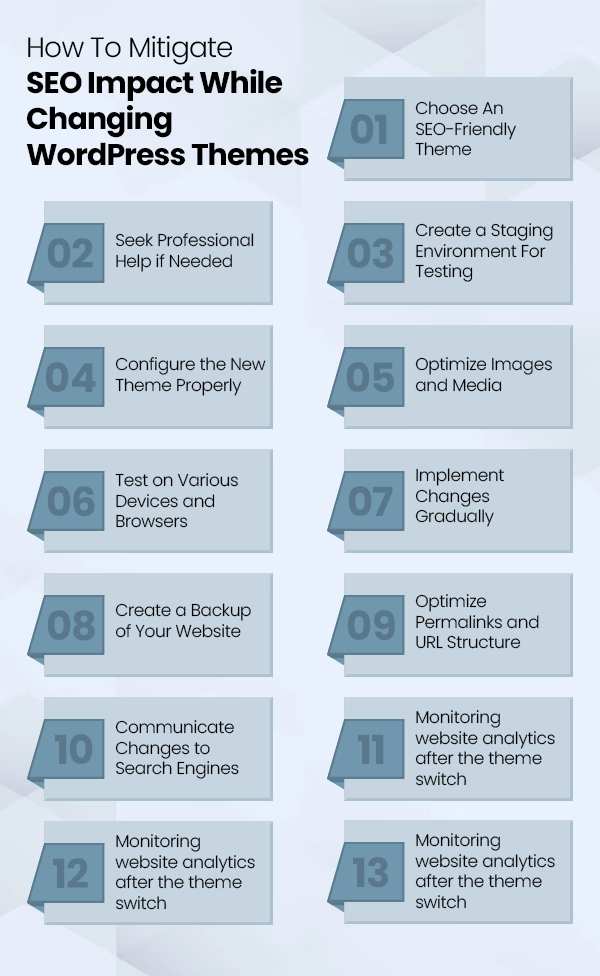
➢ Choose An SEO-Friendly Theme: When selecting a new theme for your website, you have to opt for one that is designed with SEO principles in mind. This means it should have clean code, fast loading times, and be mobile-responsive.
➢ Seek Professional Help if Needed: In case, you are unsure about making the change yourself, it is wise to seek assistance from a professional with experience in WordPress and SEO.
➢ Create a Staging Environment For Testing: Before making any changes live, don’t forget to create a staging environment where you can test the new theme without affecting your website. This practice ensures that any issues will be addressed before going live.
➢ Configure the New Theme Properly: Once you have chosen your new theme, You need to make sure that it is configured properly according to your SEO needs or not. This includes setting up titles, meta descriptions, and other important SEO settings.
➢ Optimize Images and Media: Ensure that all images and media used in your new theme are optimized for speed and SEO. This includes proper formatting of images and using descriptive alt tags.
➢ Test on Various Devices and Browsers: It is essential to test your website on different devices and browsers to ensure that it looks and functions correctly for all users.
➢ Implement Changes Gradually: Instead of making all the changes at once, implement them gradually to minimize any potential disruptions to your SEO efforts.
➢ Create a Backup of Your Website: Before making any changes, always create a backup of your website to ensure that you can revert if anything goes wrong.
➢ Optimize Permalinks and URL Structure: Check and optimize your permalinks and URL structure to ensure they are SEO-friendly and relevant to your content.
➢ Communicate Changes to Search Engines: It is important to let search engines know about the changes to your website by updating your sitemap of the website and submitting it to search engines like Google.
➢ Test Test Test: Continuously test your website after the theme switch to identify and address any issues that may arise.
➢ Get User Feedback: Finally, gather feedback from users about the new theme to see if any usability or performance issues need to be addressed.
➢ Monitoring website analytics after the theme switch: Keep an eye on your website analytics after switching themes to monitor any changes in traffic, rankings, and user engagement.
By following these steps, you can mitigate the impact on your SEO while changing WordPress themes and ensure your website performs well in search engine results.
Conclusion
While changing your WordPress theme has the potential to impact SEO, the extent of this impact depends on various factors such as the new theme’s design, performance, and compatibility with SEO best practices.
By selecting a well-optimized theme, testing before implementation, and maintaining SEO best practices, website owners can minimize any negative effects on their site’s search engine visibility and rankings.
Ultimately, the key is to prioritize user experience and ensure that the website remains technically sound and accessible to both users and search engine crawlers.
